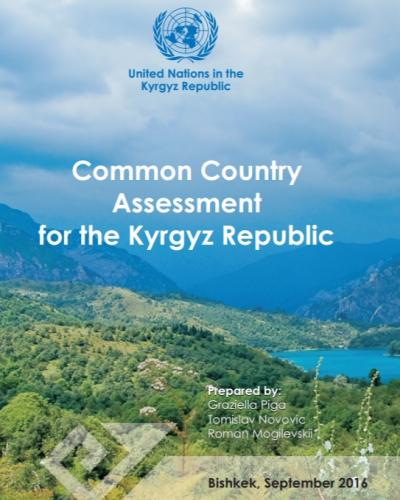Common Country Assessment for the Kyrgyz Republic

1. A Common Country Assessment (CCA) is a first step that the United Nations Country Team (UNCT) and country partners take when preparing for their next programming cycle. The CCA enables the UNCT and country partners to gain insight into the country context, identify development challenges and suggest where UNCT in the Kyrgyz Republic has a comparative advantage in supporting development priorities. Major challenges are addressed in the next step of the programming process - a multiyear United Nations Development Assistance Framework (UNDAF) - that contains results and strategies for Government of the Kyrgyz Republic-UN cooperation.
2. This Common Country Assessment for the Kyrgyz Republic is anchored in the country’s national priorities sustainable development, paying particular attention to political, economic and social agendas. Importantly, the CCA is also anchored in the Post-2015 National Consultation process that was embraced by the people of The Kyrgyz Republic as a channel to voice their opinions on development issues in their country.
3. This CCA has been developed with a gender mainstreaming and Human Rights Based Approach. This recognizes the right to development as an inalienable human right, which entitles everyone to participate in, contribute to, and enjoy economic, social, cultural and political development. It recognizes that development efforts should aim for the full realization of the entire range of rights specified under international human rights law, including civil, cultural, economic, political and social rights. The CCA also reiterates that development efforts need to be grounded in the principles of equality and non-discrimination, and promote participation, transparency and accountability.
4. The Common Country Assessment has two major and interlinked parts: the overview of the national development context; and the analysis of sectors.
5. National Development Context provides an overview of political, economic and social circumstances in the Kyrgyz Republic, focusing on themes and priorities that are driving national development agenda. It also provides insight into the state of human rights and gender equality in the Kyrgyz Republic as critical crosscutting issues.
6. The section dedicated to the analysis of sectors is structured according to the National Priorities for International Assistance (NAD), 2014-2017. The NAD was developed to increase the alignment between national priorities and international assistance so that targeted donor interventions will support mainstream public spending on policy reforms from the national budget. In addition, the NAD is intended to reduce duplication of donor activities and to rationalize these activities so that they are as cost-effective as possible.
7. This section is broad ranging. It examines critical issues related to the state of public administration, home affairs including migration issues, corruption and organised crime, human resources development and culture with the core themes of poverty and social protection, employment and the labour market, education, health, children and youth, and older people.
8. The section also includes an analysis of pressing concerns for energy, environment, and climate change, agriculture and rural development, the state of civil society, and a section on disaster risk reduction and emergency response.
9. The methodology for the CCA involved interviews and consultations with the key national and international development partners and intensive review, analysis, and synthesis of secondary data sources from the Government of the Kyrgyz Republic, the UN, and other reputable local and international sources.





















